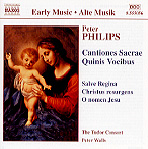The motet Mulieres sedentes, a depiction of the scene of the women weeping outside Jesus’ tomb, is among the most poignant and musically sophisticated works of the early 17th century. This five-and-one-half-minute piece shows just how accomplished this English composer was–and how sadly neglected he is today. The fact that he–a Catholic in Protestant England–chose to leave for the continent and never return, probably helped to correspondingly banish his work from its proper place alongside that of his great contemporary William Byrd, but there’s no sound musicological reason for this treatment. This selection of 16 motets from his five-part Cantiones Sacrae collection will enlighten those unfamiliar with Philips’ choral music, and will add more solid evidence to help confirm his deserved place among great Elizabethan-era composers. The equally deserving performers are the 23 voices of the Tudor Consort, a New Zealand-based ensemble that Naxos has wisely chosen to bring interpretive life to these exemplary pieces. If you want to go the best stuff first, listen to the above-mentioned Mulieres sedentes, the masterfully structured Iste est Johannes, and the very moving O Maria Mater. This is a wonderful choir–well-focused, bright-but-not-harsh sopranos, solid bass, strong inner voices–and the repertoire suits its timbre perfectly (or is it the other way around?).
Conductor Peter Walls understands both the overall period style and Philips’ own proclivity toward occasional word painting–and he obviously cares a lot about ensemble balance and uniformity of tone and color. The acoustic, which is big and resonant, sometimes works against both the choral sound and the musical detail–for example in Alma Redemptoris Mater, with its alternately boomy, murky, indistinct bass and obscure internal parts. Fortunately this is not a prominent feature of the recording in general; for the most part we get performances that show the high competence and occasional imperfections of a finely tuned, well-rehearsed, near-world-class ensemble. Interested listeners should know that another recording of selections from Philips’ five-voice Cantiones Sacrae, sharing several works with this program, has just been released by The Sarum Consort on ASV. It offers a completely different perspective–no less accomplished in terms of performance, but using only five singers and employing Philips’ subsequently-added continuo part (played on organ). The ASV recording features a much closer, more intimate acoustic setting and some very different tempos and interpretive choices in addition to its alternate musical selections. Informative notes by conductor Walls, along with full texts and translations complete this recommended Naxos release.
































